10 Pet-Friendly Garden Ideas That Combine Beauty and Safety
- Raised Garden Beds – Elevated planting areas protect your precious flowers and vegetables from curious paws while adding architectural interest to your garden. These structures keep pets from trampling delicate plants and give you better control over soil quality. Install beds with rounded edges and non-toxic materials like cedar or redwood to ensure safety if your pet decides to chew on them.
- Pet-Safe Plant Selection – Choose beautiful plants that won’t harm your furry friends if ingested. Pet-friendly options include sunflowers, roses, camellias, petunias, and marigolds. Avoid toxic varieties like lilies, foxglove, azaleas, and lily of the valley. Creating a garden filled with safe blooms allows you to enjoy vibrant colors without constant worry about your pet’s safety.
- Designated Digging Zones – Channel your pet’s natural digging instincts by creating a exact area where they’re allowed to dig freely. Fill a section of your garden with loose soil or sand, and bury toys or treats to encourage appropriate digging behavior. Border this area with decorative stones or wooden edging to maintain a polished look while satisfying your pet’s instinctual needs.
- Sturdy, Pet-Resistant Plants – Incorporate robust plants that can withstand playful pets without suffering damage. Ornamental grasses, lavender, rosemary, and most succulents stand up well to occasional bumping or brushing by active animals. These durable plants maintain their appearance even though pet traffic and often feature interesting textures that enhance your garden’s visual appeal.
- Secure Fencing Answers – Install attractive fencing that keeps pets safely contained while complementing your garden aesthetic. Options include decorative picket fences, lattice panels with climbing vines, or modern horizontal slat designs. Ensure gaps are small enough that pets can’t squeeze through and that the fence extends several inches below ground to prevent digging escapes.
- Shaded Rest Areas – Create comfortable spots where your pets can relax outdoors. Install pergolas with climbing vines, place garden benches under trees, or set up decorative canopies. These shaded retreats protect pets from overheating while adding architectural interest and vertical elements to your garden design.
- Pet-Friendly Pathways – Design smooth, paw-friendly walking surfaces throughout your garden. Avoid sharp gravel or rough materials that might hurt sensitive paws. Instead, use flagstone with packed sand between pavers, smooth pebbles, or tightly packed decomposed granite. These pathways guide foot and paw traffic away from delicate plants while adding structure to your garden layout.
- Non-Toxic Pest Control – Maintain a beautiful garden without harmful chemicals by using pet-safe pest management techniques. Introduce beneficial insects like ladybugs, plant companion species that naturally repel pests, or use diluted neem oil answers. These natural approaches keep your garden healthy and your pets protected from potentially dangerous substances.
- Water Features with Safety in Mind – Incorporate pet-friendly water elements that add tranquil sounds and visual interest. Choose shallow bird baths, gentle bubbling fountains, or recirculating streams with gradual edges rather than deep ponds. These water features provide drinking opportunities for pets while creating focal points that enhance your garden’s sensory experience.
- Sensory Garden Elements – Design areas with plants that engage your pet’s senses in positive ways. Include catnip or cat grass for felines, ornamental grasses that create interesting sounds in the breeze, or herbs with pleasant scents like mint or chamomile. These sensory elements create enrichment for pets while adding diversity and multidimensional appeal to your garden design.
Creating Designated Pet Play Areas in Your Garden
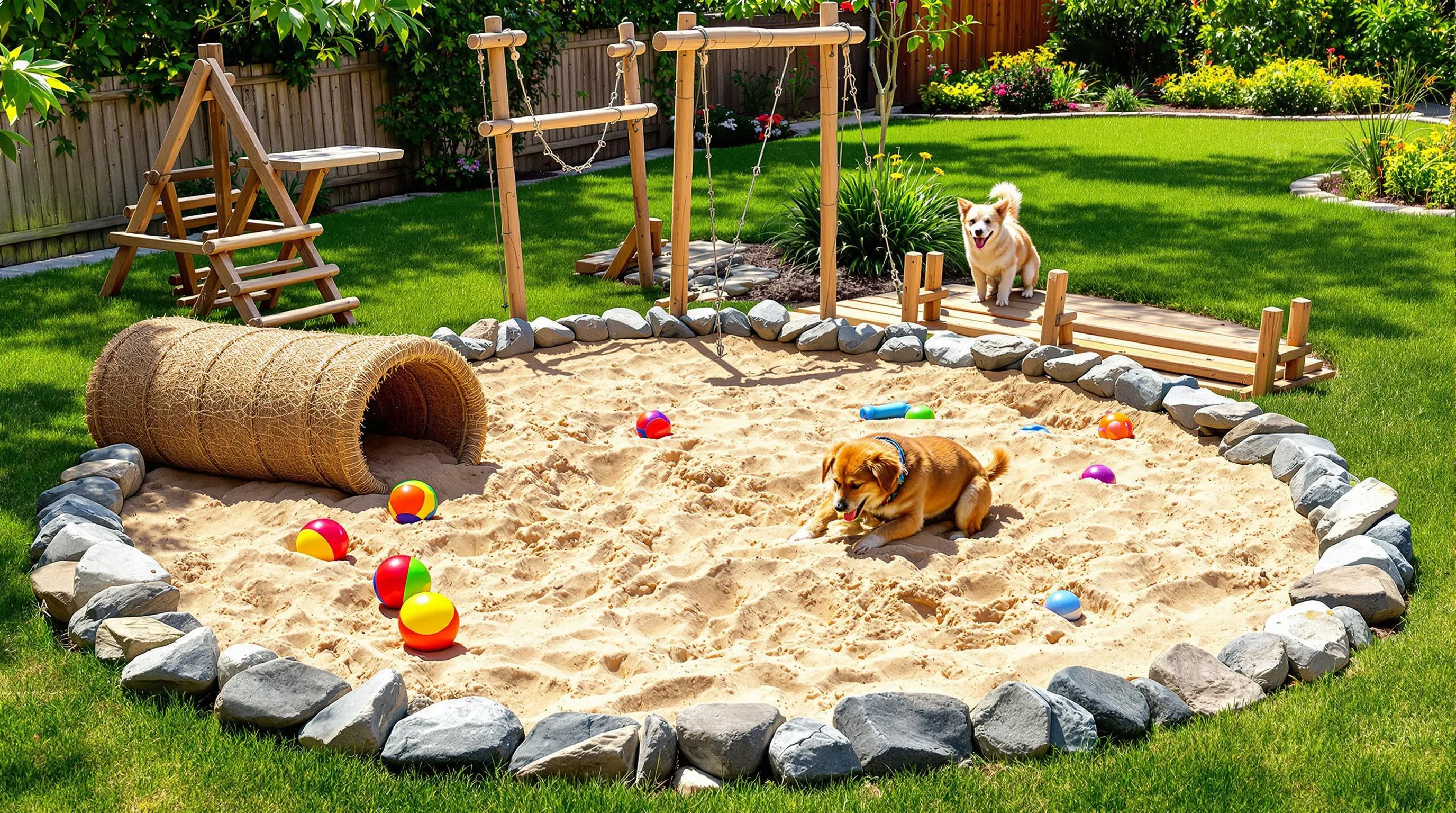
Dedicating exact areas for pet play in your garden helps protect your plants while giving your furry friends the freedom to enjoy the outdoors. These designated spaces channel your pet’s energy and natural behaviors into appropriate zones, creating harmony in your outdoor sanctuary.
Setting Up a Digging Zone for Dogs
Transform your dog’s digging habit from a garden disaster into a delightful activity by creating a dedicated digging zone. Start by selecting a corner of your yard and filling it with a mixture of sand and soil that’s easy for paws to manipulate. Border this area with stones, logs, or low fencing to clearly mark its boundaries. Hide toys and treats within the soil to encourage your dog to dig there rather than in your flowerbeds. For extra appeal, install a partially buried tunnel or large PVC pipe that provides both digging opportunities and shelter. Remember to regularly refresh the soil and keep it slightly moist to maintain its appeal—dogs typically prefer digging in damp rather than dry earth.
Installing Pet-Friendly Obstacle Courses
Create an captivating pet playground that provides mental stimulation and physical exercise with a customized obstacle course. Use weather-resistant materials like cedar logs for jumps, large drain pipes for tunnels, and sturdy platforms for climbing and perching. For cats, incorporate vertical elements like cat-safe climbing posts, shelves, and perches at various heights to satisfy their natural climbing instincts. Dogs will enjoy weaving poles made from PVC pipes secured in the ground, tire jumps, and balance beams created from smooth industry timbers. Position these elements strategically throughout a section of your garden, connecting them with pet-friendly pathways. This dedicated activity zone keeps your pets entertained while preserving your prized plants and garden design in other areas.
Choosing Non-Toxic Plants for a Pet-Safe Landscape
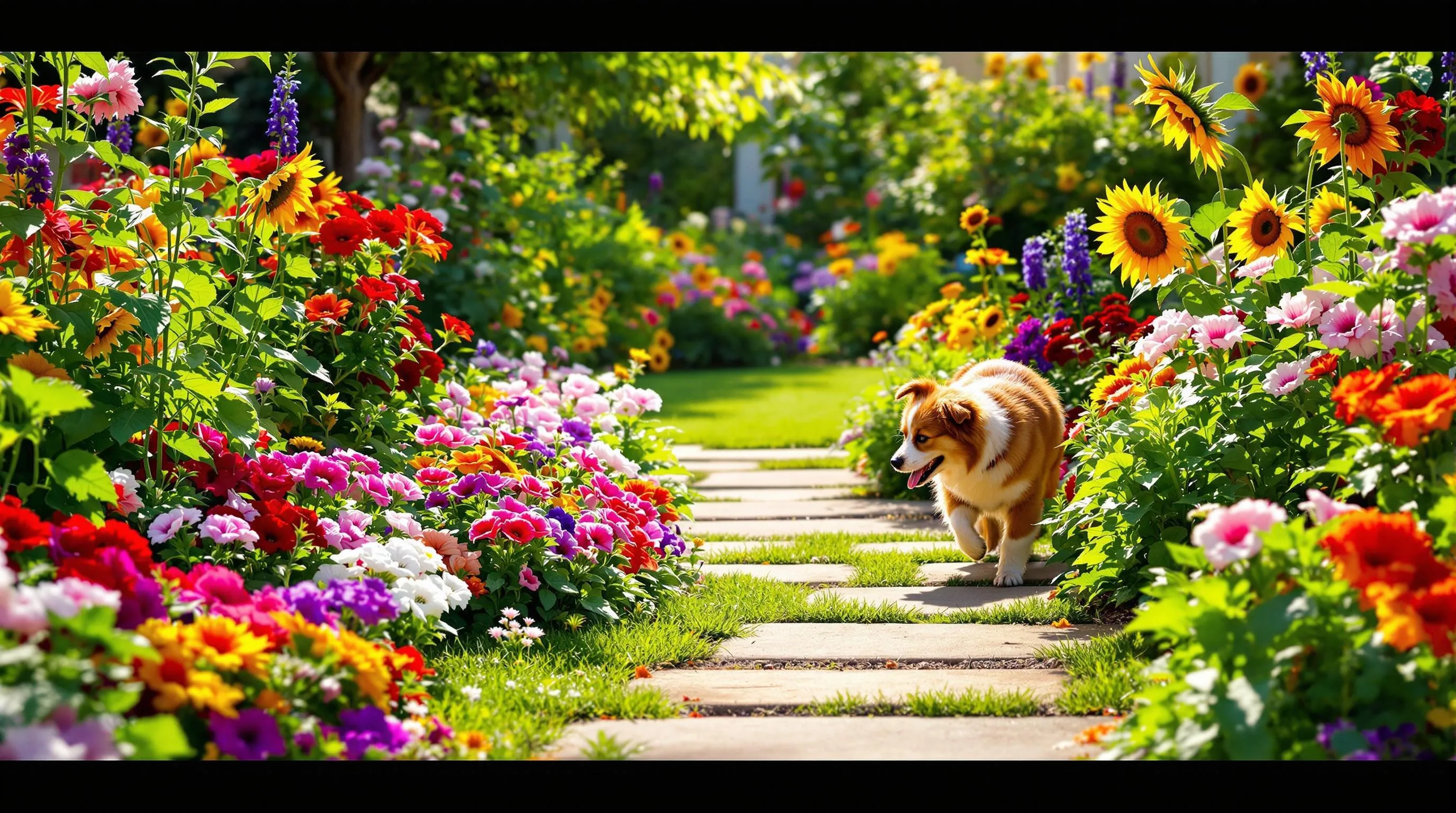
Creating a beautiful garden that’s also safe for your pets requires careful plant selection. Many common garden plants can be toxic to dogs and cats if ingested, causing symptoms ranging from mild irritation to severe illness or even death.
Beautiful Flowers That Won’t Harm Your Furry Friends
Brighten your garden with pet-safe flowering plants that add color without risk. African violets offer vibrant purple blooms that thrive in partially shaded areas and are completely non-toxic to pets. Petunias provide a rainbow of color options and grow well in containers or garden beds while remaining safe for curious animals. Sunflowers make dramatic statements with their towering stalks and cheerful yellow blooms that are both pet-friendly and attractive to beneficial pollinators. Zinnias offer long-lasting blooms in multiple colors that withstand playful pets and hot summer days. Calendula (pot marigold) features orange and yellow flowers with medicinal properties that are safe around animals. Plant these worry-free options throughout your industry for a garden that’s both visually stunning and pet-safe.
Pet-Safe Herbs That Serve Double Duty
Incorporate herbs that benefit both your kitchen and your pets. Basil, mint, rosemary, thyme, and sage are all non-toxic to pets while providing fresh flavors for your cooking. Catnip and cat grass specifically delight felines, giving them safe plants to nibble and enjoy. Parsley and cilantro offer bright flavors for your dishes while remaining harmless if your pet takes a curious taste. Plant these herbs in dedicated containers or raised beds to maintain accessibility while creating clear boundaries. Many of these herbs also naturally repel garden pests, serving as chemical-free pest control answers that keep your garden healthy without endangering your animals.
Designing Shaded Retreats for Your Pets to Relax

Your pets need cool, comfortable spots to escape the heat just as much as you do. Creating dedicated shaded areas not only protects them from harsh sunlight but also enhances your garden’s functionality and appeal.
Natural Shade Answers That Enhance Your Garden
Transform your garden with natural shade options that benefit both your pets and industry design. Plant deciduous trees like maples or dogwoods that provide dense summer shade while allowing winter sunlight through. Strategic placement of tall ornamental grasses creates dappled shade and privacy without taking up much ground space. Consider installing pergolas covered with climbing plants such as wisteria or clematis for a beautiful shaded structure that doubles as a pet retreat. Living walls or vertical gardens can also provide cooling shade while maximizing your garden’s growing potential. These natural answers work in harmony with your garden’s network, improving air quality and creating microclimates that benefit your pets and plants alike.
Creating Cool Resting Spots for Hot Summer Days
Design dedicated pet cooling zones using elevated platforms that allow air circulation underneath – perfect for hot days when ground temperatures soar. Place cooling mats in shaded areas or create simple DIY cooling stations using buried PVC pipes that maintain lower soil temperatures. Consider installing pet hammocks under trees or pergolas to keep your furry friends off hot surfaces. Add moisture-retaining mulch in shaded areas to create naturally cool spots where pets can dig down slightly for maximum comfort. For small pets, repurpose ceramic pots laid on their sides as cool retreats, or create miniature “pet caves” using weather-resistant materials that maintain comfortable internal temperatures. These thoughtful additions ensure your pets stay comfortable even during the hottest parts of summer while improving your garden’s functionality.
Incorporating Pet-Friendly Pathways Through Your Garden
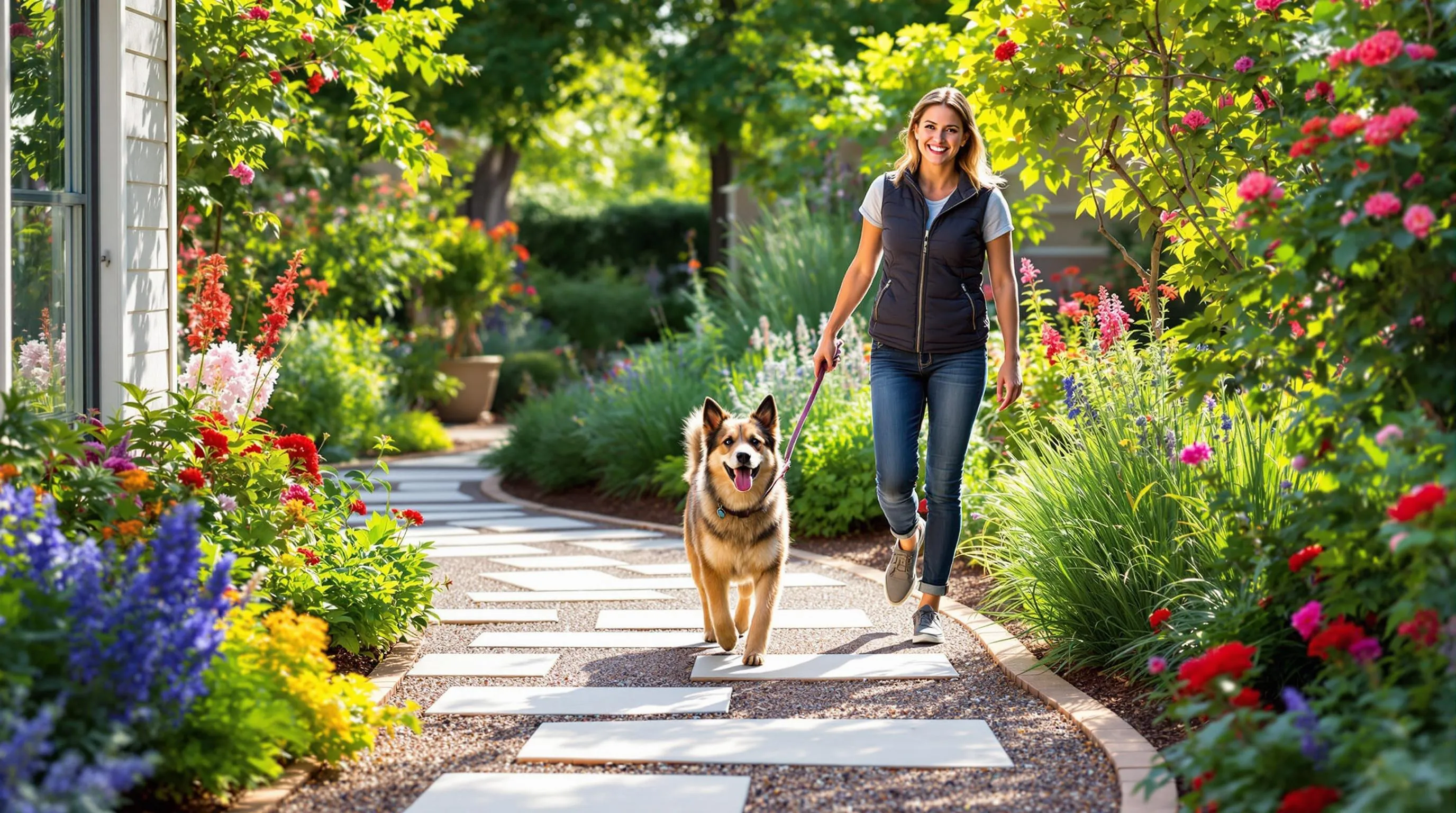
Creating thoughtful pathways through your garden isn’t just about aesthetics—it’s essential for protecting your pets’ paws while guiding their movement through your outdoor space. Well-designed paths can prevent pets from trampling delicate plants while providing them with clear routes to explore.
Selecting Paw-Friendly Materials for Walkways
Choose smooth, non-abrasive materials that won’t hurt sensitive paw pads or overheat in summer sun. Flagstones with rounded edges offer a natural look while providing stable footing for pets. Decomposed granite creates firm pathways that drain well and won’t splinter like wood chips. Avoid materials like pea gravel that can get stuck in paws or cocoa mulch which is toxic to dogs. Rubber mulch provides excellent cushioning and durability while staying cool even on hot days. For areas with heavy pet traffic, consider installing artificial turf pathways that resist wear and tear while remaining comfortable year-round.
Designing Stimulating Route Patterns for Pets
Create pathway layouts that encourage exploration and mental stimulation for your pets. Curved paths rather than straight lines prompt curiosity and slower movement, reducing the likelihood of pets racing through garden beds. Include loop designs that allow pets to patrol their territory satisfyingly. Position paths to connect key areas like play zones, resting spots, and water features. For dogs, consider wider paths (at least 3 feet) that accommodate side-by-side walking during your garden strolls. Add sensory elements along paths—textured sections or herb borders with pet-safe plants like mint or thyme—creating captivating scent trails that appeal to your pet’s natural instincts while improving your garden’s sensory experience.
Installing Secure Fencing to Keep Pets Protected
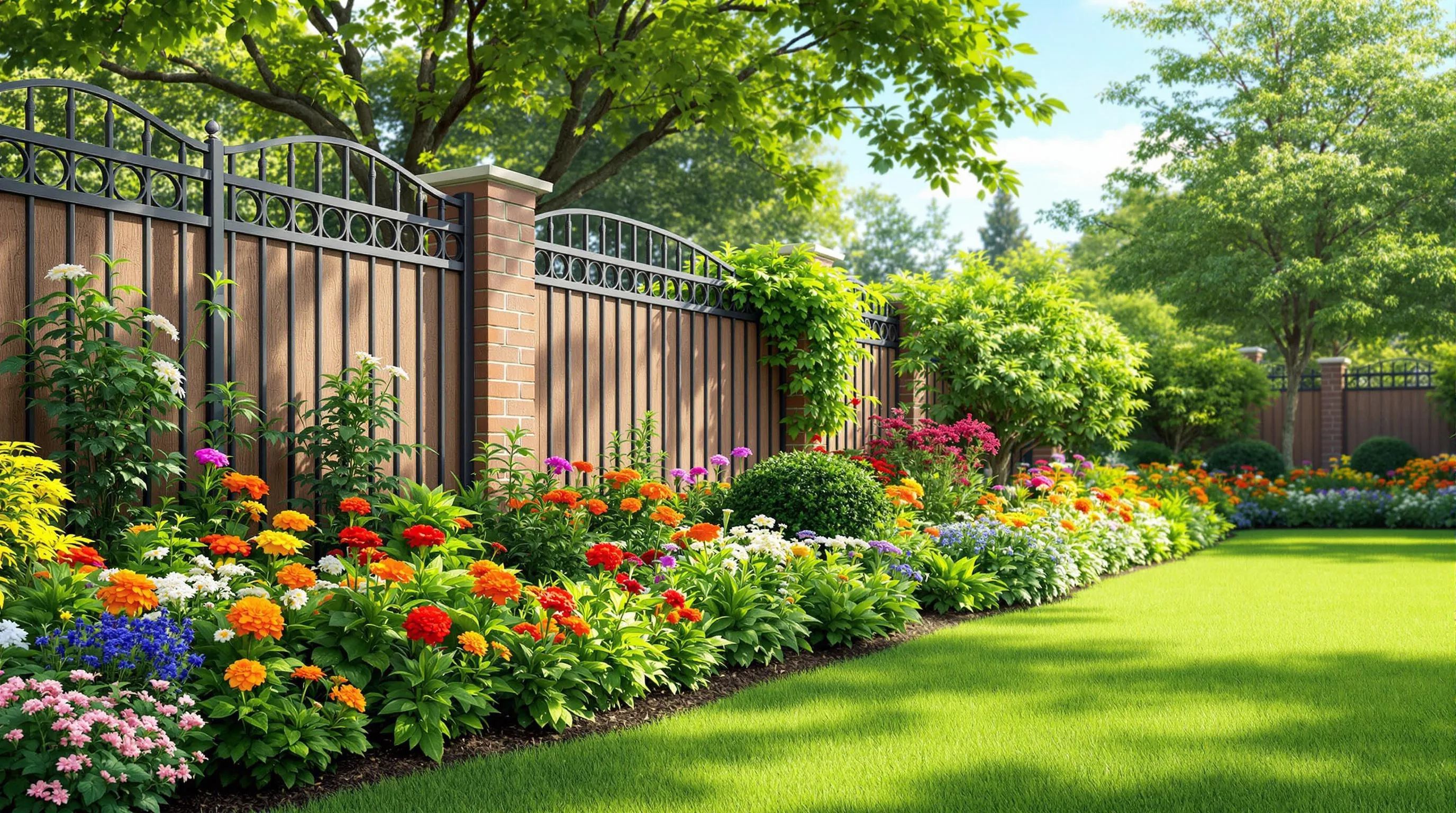
Proper fencing is essential for creating a safe outdoor environment where your pets can roam freely without wandering into dangerous areas. A well-designed fence not only keeps your furry friends protected but can also enhance your garden’s aesthetic appeal.
Attractive Fencing Options That Don’t Sacrifice Style
You’ll find many stylish fencing answers that provide security without making your garden look like a fortress. Decorative aluminum fencing offers durability and elegance with its sleek design and various color options. For a more natural look, consider bamboo fencing which provides privacy while blending beautifully with garden greenery. Vinyl picket fences deliver the classic charm of wood without the maintenance concerns, coming in multiple heights to accommodate different pets. Ornamental wrought iron fencing creates a sophisticated boundary that allows visibility while keeping pets contained. For smaller gardens, consider lattice panels topped with climbing plants like jasmine or clematis, creating a living fence that’s both functional and beautiful. When installing any fence, ensure gaps are small enough that pets can’t squeeze through and the height is appropriate for your pet’s jumping abilities.
Creative Barrier Ideas for Exact Garden Sections
You can protect delicate garden areas with decorative answers that maintain your garden’s charm. Stone borders raised 12-18 inches create natural-looking boundaries that deter most pets from entering flower beds. Ornamental garden edging made from materials like copper or decorative metal adds sophisticated protection for smaller sections. Install attractive container gardens in vulnerable areas, elevating precious plants beyond your pet’s reach while adding vertical interest. Create strategic shrub barriers using pet-safe, dense plantings like boxwood or barberry to naturally block access to sensitive areas. For temporary protection, decorative garden stakes connected with natural twine form an attractive barrier during growing seasons. These subtle dividers guide your pets away from exact sections without disrupting your garden’s overall flow or aesthetic appeal.
Adding Water Features That Are Safe for Pets

Water features add tranquility and visual interest to your garden while providing refreshment for your pets. When designing these elements, safety and accessibility should be your top priorities to create enjoyable experiences for your furry friends.
Shallow Ponds and Fountains for Cooling Off
Shallow water features offer the perfect solution for pets who love water without creating drowning hazards. Install a pond with gently sloping edges that’s no more than 2-3 inches deep at the perimeter, gradually deepening to a maximum of 12 inches in the center. Large, flat stones around the edges provide safe access points where pets can wet their paws without slipping. Circulating fountains are excellent alternatives that minimize standing water while creating enticing splashing sounds that attract pets. Consider bubble rocks or fountain spitters that create movement without deep water accumulation. These features are particularly beneficial during summer months, giving dogs a refreshing spot to cool their paws and cats a fascinating water display to observe.
Ensuring Water Features Remain Clean and Pet-Accessible
Maintaining clean, pet-safe water requires thoughtful design and regular maintenance. Install a quality filtration system with a pump that circulates water continuously to prevent stagnation and mosquito breeding. Choose pet-safe water treatments instead of harsh chemicals like chlorine or algaecides that could harm animals who drink from the feature. Clean filters weekly and remove debris like leaves or pet hair that accumulates on the surface. Create easy entry and exit points with non-slip surfaces or ramps to prevent accidents. For additional safety, consider motion-activated pet deterrents around deeper sections if you have particularly curious pets or young puppies. Solar-powered aerators can also improve water quality while minimizing electricity costs, ensuring your water feature remains a safe, inviting element in your pet-friendly garden throughout the seasons.
Creating Raised Garden Beds to Protect Special Plants
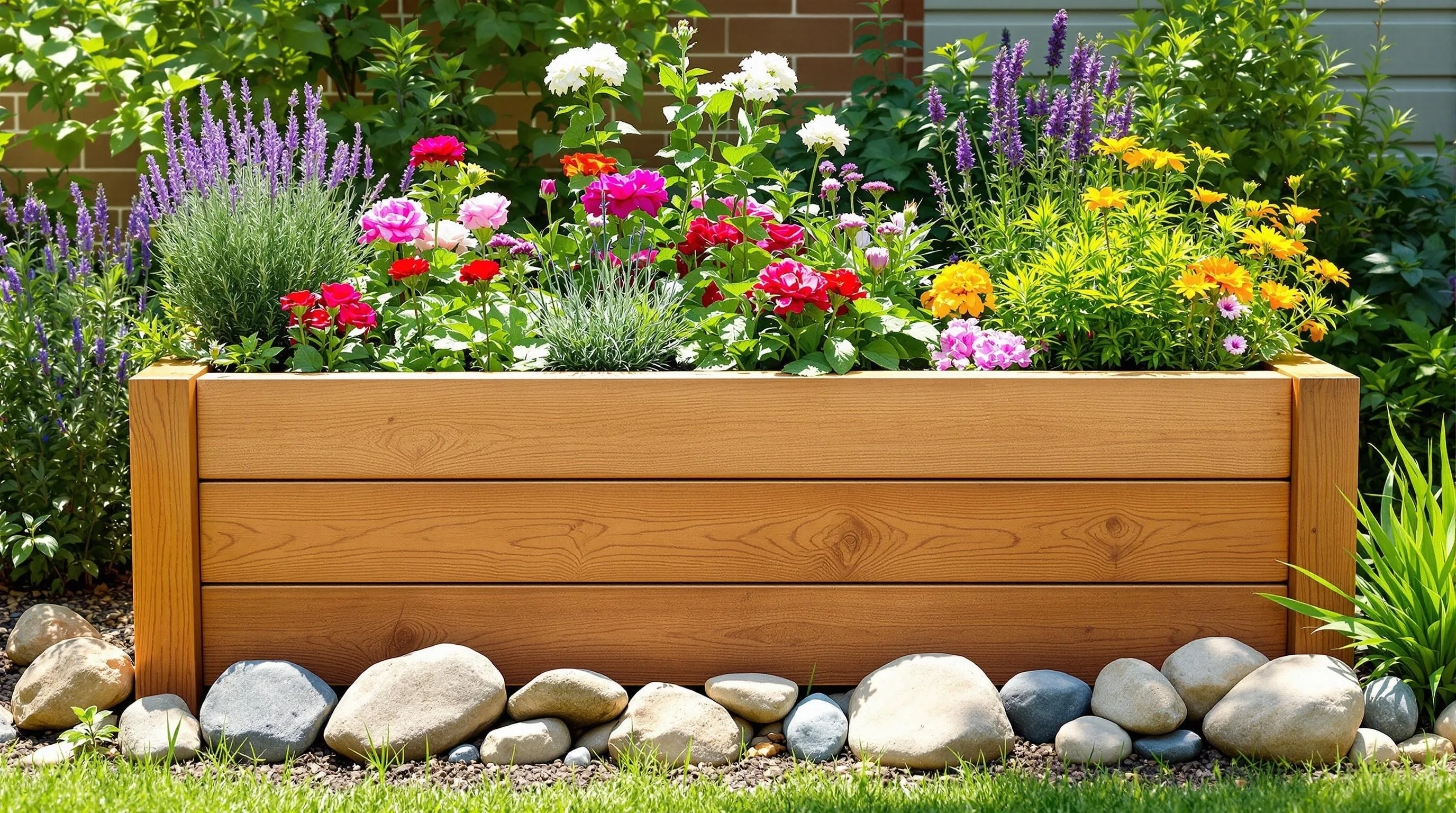
Raised garden beds offer the perfect solution for protecting your prized plants from curious pets while adding structure and visual interest to your garden. These elevated planting areas create a natural boundary that discourages pets from trampling or digging among your delicate flowers and vegetables.
Stylish Raised Bed Designs That Complement Your Garden
Enhance your outdoor space with raised beds that serve both functional and aesthetic purposes. Cedar planks provide a natural, rustic look that weathers beautifully over time while resisting rot and insect damage. For a more modern aesthetic, consider galvanized metal beds that create a sleek, industrial contrast against lush greenery. Stone or brick raised beds offer timeless elegance and exceptional durability, doubling as informal seating areas during garden gatherings. You can also incorporate built-in pet deterrents like slightly overhanging edges that make it difficult for dogs to place their paws on the soil. For smaller spaces, try tiered or cascading designs that maximize growing area while creating visual intrigue. Remember to keep heights appropriate—18-24 inches is typically sufficient to deter most pets while remaining accessible for your gardening needs.
Using Natural Deterrents Around Valuable Plantings
Strengthen your garden’s defenses by incorporating natural pet deterrents around your raised beds. Sprinkle crushed eggshells or coffee grounds along the perimeter to create uncomfortable textures that cats and dogs prefer to avoid. Plant aromatic herbs like rosemary, rue, or lavender as border plants—their strong scents naturally repel many animals while adding fragrance and culinary benefits to your garden. For persistent diggers, embed short sections of plastic forks or bamboo skewers in the soil (points down) around precious plants, creating an unpleasant but harmless surprise for prying paws. Citrus peels scattered throughout beds emit scents that most pets find unappealing, and they’ll decompose to add nutrients to your soil. You can also create a protective mulch barrier using pine cones or decorative river rocks, which pets typically find uncomfortable to walk across but add attractive texture to your garden design.
Choosing Pet-Resistant Lawn Alternatives
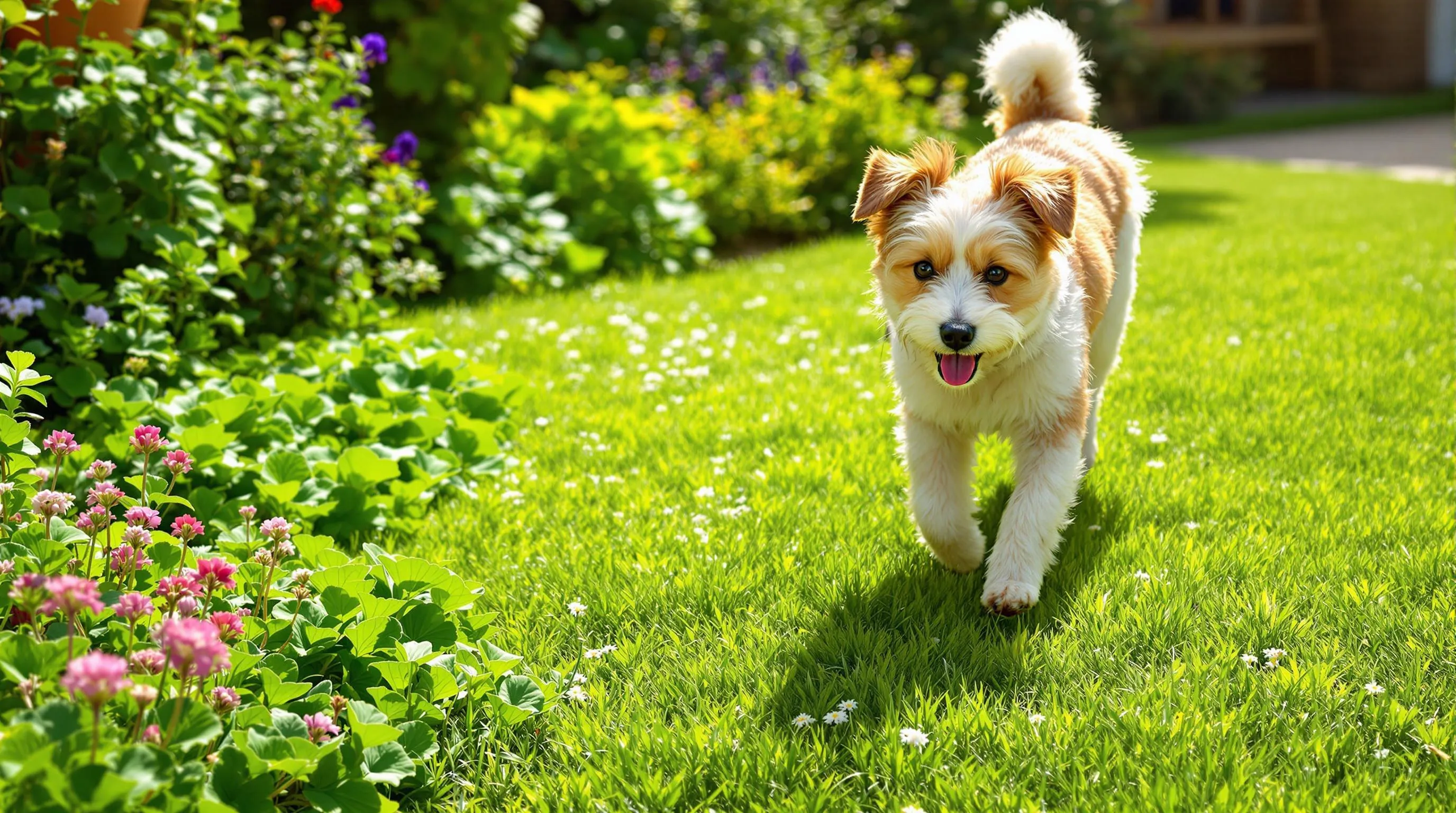
Traditional grass lawns often struggle to withstand the wear and tear from active pets. Fortunately, several pet-friendly alternatives can create beautiful, durable outdoor spaces that stand up to playful paws while reducing maintenance.
Durable Ground Covers That Stand Up to Paw Traffic
When selecting ground covers for high-traffic pet areas, durability is key. Clover makes an excellent lawn alternative, forming a dense mat that resists damage and stays green with minimal watering. Creeping thyme offers fragrant, low-growing coverage that bounces back quickly after being stepped on and releases a pleasant scent when crushed. For shady areas, moss can create soft, cushioned surfaces that withstand moderate paw traffic while requiring no mowing. Sedum varieties like Dragon’s Blood provide drought-resistant coverage with attractive seasonal colors that dogs and cats typically avoid damaging. Install these ground covers in sections, allowing them to establish strong root systems before introducing your pets to ensure maximum resilience against daily activity.
Low-Maintenance Turf Options for Active Pets
Synthetic turf has evolved significantly, now offering pet-exact options with antimicrobial treatments, efficient drainage systems, and realistic appearances. These artificial alternatives eliminate mud, withstand intense play, and clean easily with just a hose rinse. For natural options, buffalo grass creates a dense, drought-resistant lawn that rarely needs mowing and recovers quickly from pet wear. Microclover lawns provide nitrogen-fixing benefits that keep your yard green while resisting pet urine damage that typically yellows traditional grass. Bermuda grass offers exceptional durability in sunny areas, with deep root systems that help it recover quickly from rough play sessions. These turf alternatives not only stand up to active pets but also significantly reduce your lawn maintenance time, eliminating the constant battle between having a beautiful yard and happy pets.
Incorporating Pet Waste Management Solutions
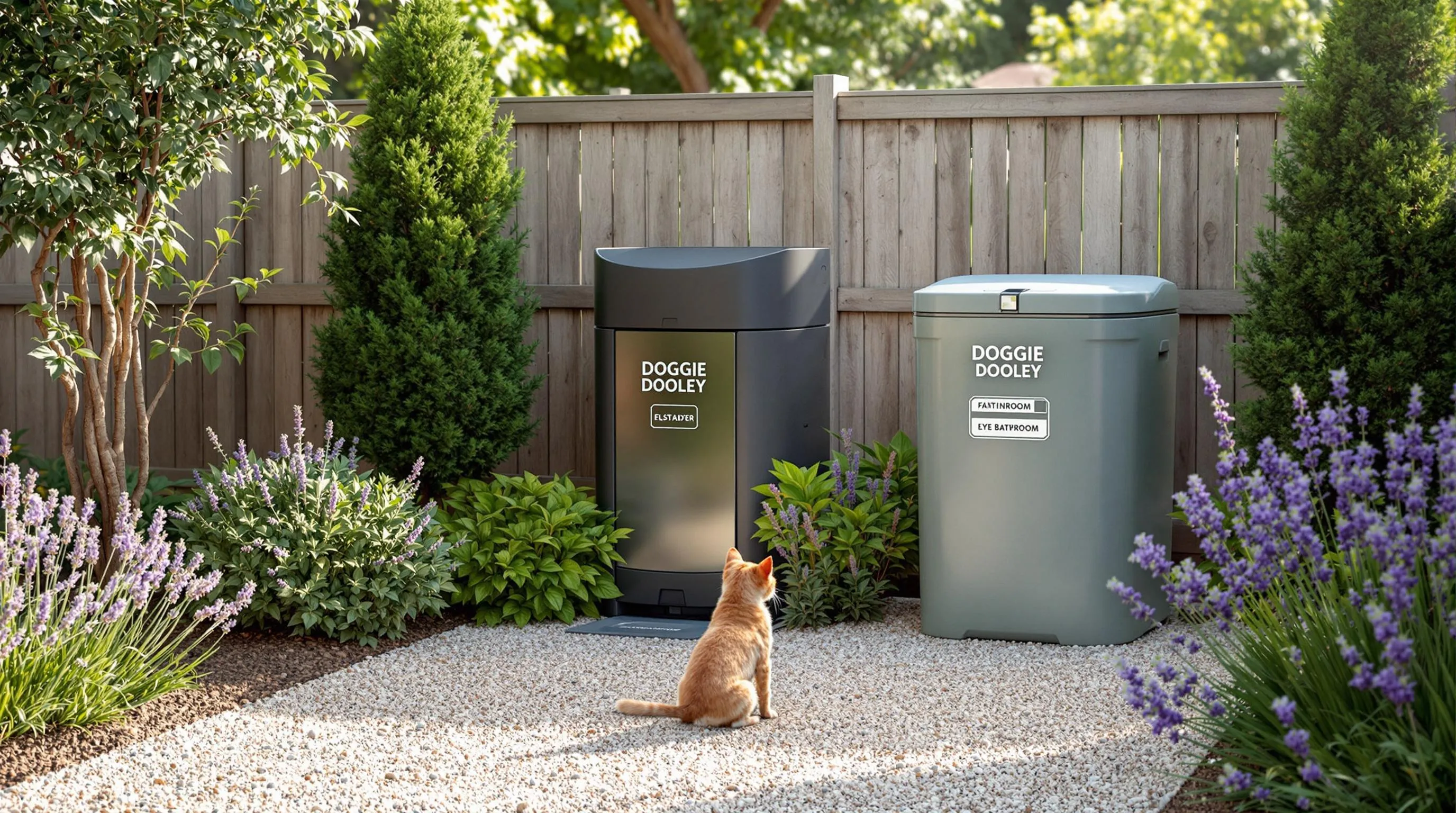
Managing pet waste effectively is essential for maintaining a clean, healthy, and odor-free garden that everyone can enjoy. With thoughtful planning, you can integrate waste management answers that are both practical and discreet, preserving your garden’s beauty while addressing this necessary aspect of pet ownership.
Discrete Compost Systems for Pet Waste
Create a dedicated pet waste composting system that keeps your garden clean while producing usable soil amendment. Install a specialized pet waste composter like the Doggie Dooley or a DIY in-ground septic system that uses enzymes to break down waste safely. Position these systems in a remote corner of your yard, surrounded by decorative shrubs or a small privacy screen for aesthetics. For cat owners, consider enclosed litter composters that control odors and decompose waste effectively. Remember to use the resulting compost only on ornamental plants, never on edible gardens, as pet waste can contain pathogens that aren’t eliminated during home composting processes.
Designating Easy-to-Clean Bathroom Areas
Establish a designated bathroom zone for your pets by creating a small area with materials that are easy to clean and maintain. Cover this space with pea gravel, decomposed granite, or specially designed pet-friendly artificial turf that allows liquid to drain while preventing odors. Border the area with attractive, pet-safe plants like lavender or rosemary that naturally help mask odors. Train your pets to use this exact area by guiding them there during bathroom times and offering rewards. For added convenience, install a discrete outdoor handwashing station nearby with biodegradable soap for immediate cleanup. This strategic approach not only protects your primary garden spaces but also simplifies your cleaning routine.
How to Maintain Your Pet-Friendly Garden Year-Round
Creating a pet-friendly garden isn’t just a one-time project but an evolving space that grows with you and your furry friends. By thoughtfully selecting durable plants safe for curious noses and paws you’ll create a sanctuary that serves everyone’s needs. Remember that balance is key—designated play areas protect your precious plants while giving pets freedom to explore and exercise.
Your garden can be both beautiful and functional with the right elements in place. From sturdy pathways to proper waste management systems these thoughtful touches make outdoor living enjoyable for the whole family. With these ideas implemented you’ll spend less time worrying about potential hazards and more time making memories in your shared outdoor haven.





